How I Do It: Literacy, Language, and AAC with Jeanna Antrim
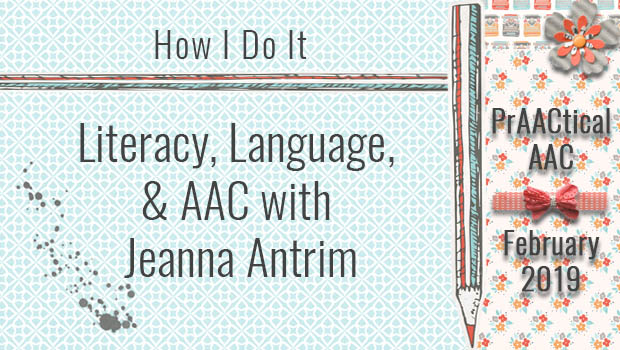

We have deep respect for clinicians and educators who are willing to share their approach to developing strong AAC instructional sessions. Today, we are excited to welcome SLP Jeanna Antrim to these pages. Jeanna has been an SLP for the past 7 years practicing at special education cooperatives in southern Illinois. She works both with students in a self-contained behavior school and as an AAC facilitator conducting AAC evaluations, providing direct therapy, and consulting with school teams. In this post, she shares her approach to developing AAC sessions using shared reading. (Don’t miss her book packet and handouts.)
:::::::::::::::::::::::::::::::::::::::::::::::::::::::::::::::::::::::::::::::::::::::::::::::::::::::
How I Do It: Literacy, Language, and AAC
After graduating, it took me a few years of trial and error before I figured out (and don’t get me wrong I’m still figuring out) my niche. I absolutely love books and love how I can target any language and communication concept within a context by using a book in therapy.
Here is a peek at a typical week’s lesson plan:
1) Choose Book—I typically have a monthly theme. This allows me to narrow my book search and it also lets me target my fringe vocabulary for a full month. Recent research has shown that kids need 36 opportunities with a word before acquiring it (Storkel et al. 2017) so a month-long immersion theme is perfect! The book I chose for this blog is the ultimate classic, The Gruffalo by Julia Donaldson and Axel Scheffler.
2) Core Vocabulary—I typically choose core vocabulary words based on if they are repeated frequently or if any of the core words align with certain objectives that my students have in their Individualized Education Plans (IEPs). In this book, I chose to target the following sets of core words:
>Repeated: where, good
>Greetings: goodbye, hello
>Adjectives: terrible, silly
*I typically only focus on one of these sets per student or group. It all just depends on their level of communication or what function of communication I need to model/target.
3) Fringe Vocabulary—I focus on any nouns that are important throughout the story and/or fall in line with my monthly theme. For this book, I chose the following words:
>Fox, Owl, Snake, Forest, Mouse, Gruffalo
*If these words are in my student’s device already, great! If not, it’s not a big deal. I do not typically add any nouns to a student’s device unless they show repeated interest over a few sessions in the word. I usually just have these words on a flip board that can be attached to their core communication board or that I can have on the side during our lessons. I then make sure to also model descriptions of the fringe vocabulary so they can still communicate that word once we end the monthly theme.
4) Shared Reading Session—My first session with the student in the week involves doing a shared reading session. Shared reading sessions are perfect for promoting literacy, modeling, stimulating language, and eliciting novel utterances. To learn more about Shared Reading, visit Literacy for All Shared Reading and see the CAR Handouts below from Edmonton Regional Learning Consortium). There are lots of ‘moving parts’ within one of my shared reading sessions, so I will break it down into sections.
- A) Picture Walk Through—I do this for two main reasons: (1) to introduce vocabulary and (2) to access and build background knowledge. I also take this time to model the core and fringe words I have selected.
- B) Letter Identification—Don’t forget to target phonemic awareness skills! It’s so easy, especially with our AAC kids, but I implore you not to forget. It’s too important and can open so many doors down the road. For this book, I chose to focus on letter identification and planned to target the letter ‘Gg’. All this means is that on every 2-3 pages I model or ask my student to find “our letter”. We access either the student’s keyboard page within their device or the alphabet board on the back of their core board.
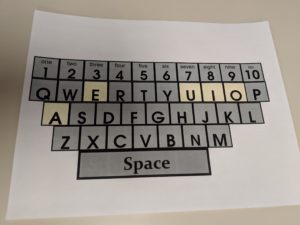
- C) Read—While actually reading the book, I use the CAR strategy to enrich the experience even more. The CAR strategy stands for
C-Comment (and wait)
A-Ask a CROWD question (and wait)
R-Respond and add more
I use the CAR strategy for two main reasons: (1) it helps remind me to wait and pause for a response and (2) it helps me remember to ask a variety of questions (by putting the CROWD in the CAR) and avoid the typical yes/no questions. I typically forget, in the moment, to vary my questions and will often get stuck on one type of question, so I cheat/prep ahead of time. I will write questions on post-its and make sure I hit each question type of CROWD. 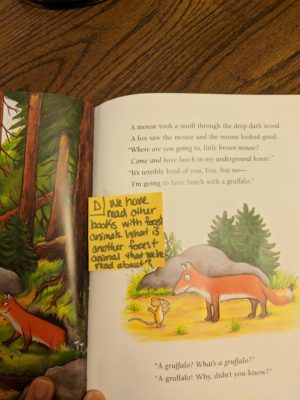 For this book my questions were as follows:
For this book my questions were as follows:
- C (Completion)-pg.9—It’s wonderfully good of you Snake, but __.
- R (Recall)-pg.18—What happened when the snake saw the mouse and Gruffalo?
- O (Open-Ended)-pg.13—Tell me what you see in this picture.
- W(WH question)-pg.20—What is the fox doing?
- D (Distance)-pg.1—We have read other books with forest animals. What is another forest animal that we’ve read about?
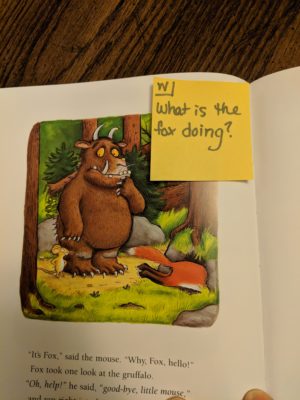
To see how I model & incorporate these questions during a reading session, you can visit my YouTube channel. I have 3 videos for this book, a video per each set of core words. And to download visuals of the CAR/CROWD strategy visit Literacy for All Shared Reading and see the CAR strategy handout in the download below!
- D) Story Props—During my reading session, I also have story props the students can use to help tell the story. Again, my love for books is strong! And I love Pinterest—who doesn’t? So the two go hand-in-hand and I love figuring out what props I would like to make for each story. I have done everything from just printing pictures and attaching them to blocks or stackable cups, making felt puppets, to dressing up like an Old Lady and pretending to swallow various objects!
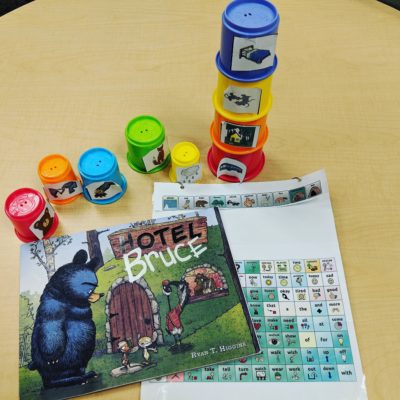
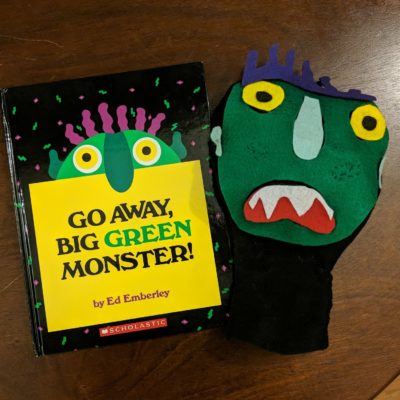 For this story I chose to do a box diorama with the story characters attached to craft sticks Research has repeatedly shown that using story props increase student engagement and attention, and they are so much fun, so why not?
For this story I chose to do a box diorama with the story characters attached to craft sticks Research has repeatedly shown that using story props increase student engagement and attention, and they are so much fun, so why not?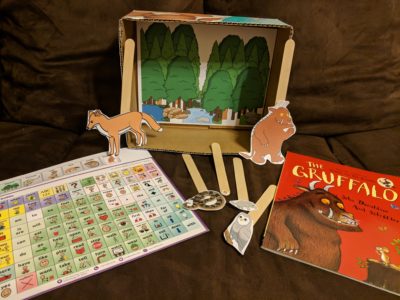
5) Follow-Up Activities—During other follow-up sessions, I have other activities or sometimes, depending on the student and how long I see them, I can do 1 or 2 of these activities during that first session.
- A) Story Retell—I love doing this to help review the story, teach/practice sequencing, and also to model and review vocabulary.
- B) Comprehension WH Questions—I usually have a worksheet that I have made with basic WH questions to identify various elements of the story. Sometimes I also use a question pyramid if I don’t have a worksheet ready to go.
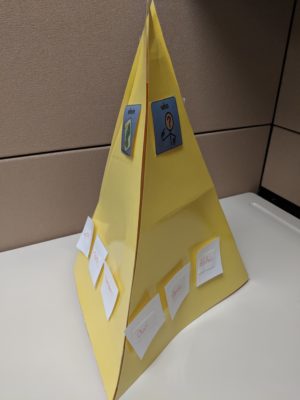 Questions I chose for this book were:
Questions I chose for this book were:
(1) What did the mouse eat at the end of the story?
(2) Who was the smartest animal?
(3) Where did the snake hide?.
- C) Predictable Chart Writing—Full disclosure, I do not do all 5 days of the predictable chart writing (for more information visit Literacy for All Shared Writing and see the Predictable Chart Writing Handout from The Center for Literacy and Disability Studies included in the download below). However, I do implement one component of this process. After reviewing the story, I have a sentence started and prompt the students to finish the sentence. For this story, my sentence was: My favorite food is__. I chose this as my sentence since the story is constantly referencing the animals eating either the mouse or the Gruffalo’s favorite food.

- D) Craft—Let’s be honest, what kid doesn’t love a craft? And I will be honest, aside from books, I LOVE crafts and all of the spontaneous communication you can achieve during the activity. Also, I love crafts that can be open-ended in a sense, to let the child’s creativity come through! During craft time, I take the opportunity to model and target the vocabulary again, compare and contrast (i.e., in this book we compared and contrasted the Gruffalo against the other forest animals), target body parts and adjectives, spatial concepts, and the student’s ability to follow one to two-step directions.
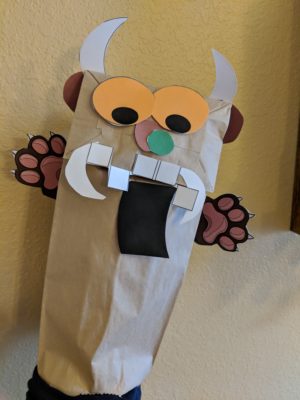

- E) Writing Topic Page—Literacy is so important! So in addition to phonemic awareness and shared reading, I have begun to encourage my students to write in every session. It can range from them writing their name on their craft, participating in the predictable chart writing, and for those who can, writing one-two sentences on a writing prompt page. For this book, I asked my student’s to draw and write about something that scares them. For more information on how to provide access to writing and the importance of including this in your therapy sessions, visit Literacy for All.
Now, this may seem overwhelming at first, but it really isn’t. Like everything in life, once you get started and just plunge forward, it all falls into place seamlessly. And to help you get started I have attached a free book companion packet with all of the components I have mentioned in this blog!
Click here to download Jeanna’s book packet and CAR and predictable chart writing handouts.
:::::::::::::::::::::::::::::::::::::::::::::::::::::::::::::::::::::::::::::::::::::::::::::::::::::::::::::::::::::
From the Guest Author: Follow me on my two Instagram accounts @speechwithoutlimits and on my collaborative work Instagram @bassaac. You can also follow me on my Facebook page for more implementation ideas! Subscribe to my YouTube Channel for modeling AAC tips and demonstrations of how to model in books! More book companion packets are available in my TPT store.
References
Storkel, H. L., Voelmle, K., Fierro, V., Flake, K., Fleming, K. K., & Romine, R. S. (2017). Interactive Book Reading to Accelerate Word Learning by Kindergarten Children With Specific Language Impairment: Identifying an Adequate Intensity and Variation in Treatment Response. Language, Speech, and Hearing Services in Schools, 48, 16-30. doi: 10.1044/2016_LSHSS-16-0014
Filed under: Featured Posts, PrAACtical Thinking
Tagged With: book packet, core vocabulary, download, How I Do It, shared reading
This post was written by Carole Zangari
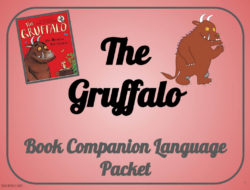

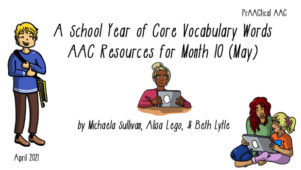
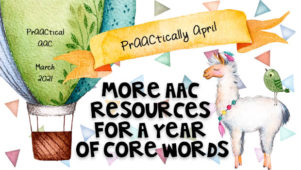
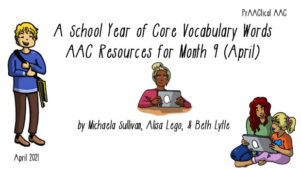
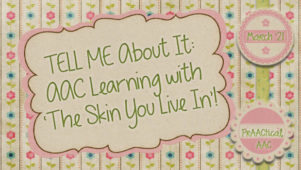
6 Comments
Brilliant!! And so well organized and thought out, thank you for sharing!
Thank you so much for your feedback!!!
Jeanna is a wonderful teacher ! She doesn’t just teach the children but gives the parents resources they can use for every day practical application. Thank you for your dedication Jeanna
Aleaha’s Mom
Kellie Bradshaw
Thank you so much for your kind words!!!
What vocabulary do you have printed out? what layout is that?
I used the 96 location Word Power Vocabulary manual communication board from Saltillo. It is available as a free download from their website.